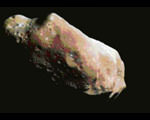
Image credit: NASA
The simple answer to this question is “no”. There are limited search and detection programmes in operation, mainly in the US, but these are only designed to detect large asteroids in the 1 km plus range. NASA funds four such programmes, and contributes to a fifth.
Were an asteroid to be detected on a collision course with Earth our response would depend on the warning time. If the collision were to occur within days, weeks or months there is nothing that we can do except make plans for the aftermath. We would need a few decades to be sure of having an effective response.
One of the major problems is that a collision will not be certain until it is far too late to mount a mitigation project – it’s all a matter of probabilities. It will be a political decision as to when we take action, and there is no concensus as to when this should be. Do we act when the impact probability is 1:1 million, 1:1000, 1:100 or 1:10? The longer we wait, the more difficult the job will be.
Jay Tate is a member of the Board of Directors of the International Spaceguard Foundation, a consultant to the International Astronomical Union Working Group on Near Earth Objects. He is the Director of the Spaceguard Centre in mid-Wales.
